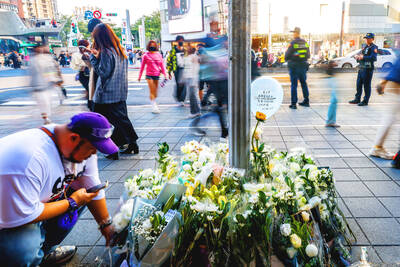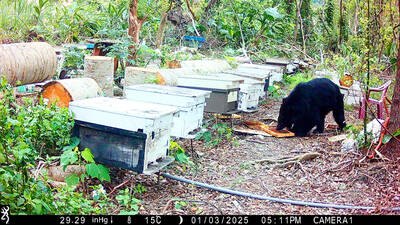An exhibition of once banned dangwai (黨外, “outside the party”) movement magazines published between the 1970s and 1980s has opened in Taipei as part of the nation’s commemorations of the 30th anniversary of the lifting of martial law.
Featuring more than 20 different covers from Formosa (美麗島), 1980s (八十年代), Freedom Era Weekly (自由時代周刊) and other magazines, the exhibition covers several walls of To-uat Books x Cafe Philo (左轉有書x慕哲咖啡), a prominent bookstore and coffee shop operated by several labor and human-rights advocacy groups.
“Our own group was established in 1984 during the Martial Law era, so we also had to deal with the effects of government repression,” Taiwan Labor Front secretary-general Son Yu-liam (孫友聯) said. “The resistance of dangwai magazines played a crucial role in Taiwan’s democratization, so we hope to use this exhibition to help more people understand the sheer number of people involved in pushing for the end of martial law and Taiwan’s eventual democratization.”
The most notable exhibits are two editions of Freedom Era Weekly from the week before and week after the lifting of martial law on July 15, 1987, he said.
Published in numerous incarnations by democracy activist Deng Nan-jung (鄭南榕) from 1984 to 1989, the magazine repeatedly evaded attempted government bans, only ending publication after Deng immolated himself in the magazine’s offices to resist arrest for publishing a draft constitution of a proposed “Republic of Taiwan,” that challenged a ban on advocating Taiwanese independence.
Beginning this year, the April 7 anniversary of his death is to be celebrated nationally as “Freedom of Speech Day.”
National Chengchi University history professor Hsueh Hua-yuan (薛化元) said that Deng was also notable for his ability to take advantage of loopholes in magazine publication regulations to keep Freedom Era Weekly alive in the face of repeated government bans on the publication of sensitive articles.
“There were different requirements you had to meet, including having a ‘proper’ stated purpose — but you could re-register the same magazine if you changed the name and found someone who was willing to attach their name to it and Deng was able to find a lot of willing people,” he said.
According to the Nylon Cheng Liberty Foundation (whose name incorporates Deng’s English nickname) figures, the magazine was published under 23 different titles, with commemorative issues for the lifting of martial law published during a brief period in which it resumed its original title.
While alternative title issues of Freedom Era Weekly are not on display, viewers can still see the “title switch” tactic up close by examining covers of the magazines 1980s and Asian Monthly (亞洲人), a later incarnation.
It also features covers from the short-lived 1979 magazine Formosa, which had a huge impact on the nation’s after numerous staff members were arrested for organizing a pro-democracy rally in Kaohsiung.
Many staff members — including now Kaohsiung Mayor Chen Chu (陳菊) — went on to become prominent figures in the Democratic Progressive Party, as did their defense lawyers.
“At the time, you had to use magazines, because only magazines could be registered,” said Hsueh, referring to a ban on new newspaper registrations during the Martial Law era.
The exhibition runs through Sunday at 3 Hao Shaoxing N Rd in Taipei’s Zhongzheng (中正) district near Shandao Temple MRT station.

SHIPS, TRAINS AND AUTOMOBILES: The ministry has announced changes to varied transportation industries taking effect soon, with a number of effects for passengers Beginning next month, the post office is canceling signature upon delivery and written inquiry services for international registered small packets in accordance with the new policy of the Universal Postal Union, the Ministry of Transportation and Communications said yesterday. The new policy does not apply to packets that are to be delivered to China, the ministry said. Senders of international registered small packets would receive a NT$10 rebate on postage if the packets are sent from Jan. 1 to March 31, it added. The ministry said that three other policies are also scheduled to take effect next month. International cruise ship operators

HORROR STORIES: One victim recounted not realizing they had been stabbed and seeing people bleeding, while another recalled breaking down in tears after fleeing A man on Friday died after he tried to fight the knife-wielding suspect who went on a stabbing spree near two of Taipei’s busiest metro stations, Taipei Mayor Chiang Wan-an (蔣萬安) said. The 57-year-old man, identified by his family name, Yu (余), encountered the suspect at Exit M7 of Taipei Main Station and immediately tried to stop him, but was fatally wounded and later died, Chiang said, calling the incident “heartbreaking.” Yu’s family would receive at least NT$5 million (US$158,584) in compensation through the Taipei Rapid Transit Corp’s (TRTC) insurance coverage, he said after convening an emergency security response meeting yesterday morning. National

The Forestry and Nature Conservation Agency yesterday launched a gift box to market honey “certified by a Formosan black bear” in appreciation of a beekeeper’s amicable interaction with a honey-thieving bear. Beekeeper Chih Ming-chen (池明鎮) in January inspected his bee farm in Hualien County’s Jhuosi Township (卓溪) and found that more than 20 beehives had been destroyed and many hives were eaten, with bear droppings and paw prints near the destroyed hives, the agency said. Chih returned to the farm to move the remaining beehives away that evening when he encountered a Formosan black bear only 20m away, the agency said. The bear

PLANNED: The suspect visited the crime scene before the killings, seeking information on how to access the roof, and had extensively researched a 2014 stabbing incident The suspect in a stabbing attack that killed three people and injured 11 in Taipei on Friday had planned the assault and set fires at other locations earlier in the day, law enforcement officials said yesterday. National Police Agency (NPA) Director-General Chang Jung-hsin (張榮興) said the suspect, a 27-year-old man named Chang Wen (張文), began the attacks at 3:40pm, first setting off smoke bombs on a road, damaging cars and motorbikes. Earlier, Chang Wen set fire to a rental room where he was staying on Gongyuan Road in Zhongzheng District (中正), Chang Jung-hsin said. The suspect later threw smoke grenades near two exits